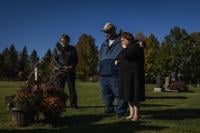CHICAGO (AP) — The operator of a Chicago commuter train that collided with snow-removal equipment last month was not at fault for the crash, which could have been prevented by a more sophisticated signal system, the ��ɫtv Transportation Safety Board said Tuesday, citing preliminary investigation data.
The federal review found the operator immediately braked once the equipment came into view. Investigators said they are focused on the design of the CTA signal system, the braking performance of the railcars involved, and whether leaf debris or other contaminants on the rails played a role.
The caused the Chicago Transit Authority, or CTA, Yellow Line train to derail. Six CTA employees were on board the rail equipment. Sixteen people were taken to a hospital, treated and released, and three were critically injured. No one died.
“All the data we’ve received and all the testing we’ve conducted indicates to us that the operator did not do anything wrong,” NTSB chair Jennifer Homendy said at a news conference Tuesday afternoon.
According to the report, the train was traveling south at about 54 mph (87 kilometers per hour) when the operator received a stop command from the signal system because of the equipment about 2,150 feet (655 meters) ahead.
The operator knew the machine would be on the line that day but wasn’t aware of its exact location, the report said.
“The operator immediately initiated a full service braking application to stop the train,” the report says. “The operator then saw the snow removal machine and initiated an emergency braking application.”
The signal system at the crash site is designed to allow a stopping distance of 1,780 feet (543 meters) or less — shorter than the distance between the train and the equipment when the operator hit the brakes — but instead of stopping, the train decelerated to about 27 mph (43 kph), striking the equipment.
The NTSB investigation is ongoing.
Although the exact cause of the crash remains unclear and additional testing is needed, Homendy added: “What I will say is when the CTA’s transit system and trains were configured, it was quite a while ago.”
Many factors affect stopping distance, including train weight, length, track incline, environmental conditions and debris, she said.
“Over time things change on the transit system. And so we’re going to look at, was stopping distance something that CTA re-evaluated over time? Did they look at their braking algorithms? Did they look at their signal configuration over time and testing? So that’s something we will be looking at further.”
A , known as Positive Train Control or PTC, would have prevented the crash, Homendy said.
“If the signal saw something was up ahead, there’s no way that train with PTC would ever get past that signal. It would stop it well in advance," she said.
Homendy emphasized that passenger rail overall remains an “extremely safe” mode of transportation.
___
Savage is a corps member for the Associated Press/Report for America Statehouse News Initiative. is a nonprofit national service program that places journalists in local newsrooms to report on undercovered issues.








































